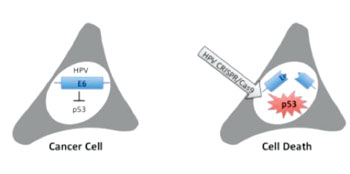Gene Therapy Reactivates Cell Death Pathways in Cervical Cancer Cells
By LabMedica International staff writers
Posted on 18 Aug 2014
A team of molecular virologists has presented evidence demonstrating the possibility of developing anticancer therapies based on viral vectors that transfect carcinoma cells with RNA-protein complexes capable of reactivating genes in the cancer cells that cause cell cycle arrest and eventual cell death.Posted on 18 Aug 2014
Investigators at Duke University (Durham, NC, USA) worked with human cervical cancers caused by the HPV-16 and HPV-18 serotypes of human papillomavirus (HPV). Growth of HPV-induced cancers was known to depend on the two HPV oncogenes, E6 and E7. E6 induces degradation of the cellular tumor suppressor p53, while E7 destabilizes the retinoblastoma (Rb) protein.

Image: Using CRISPR to silence the E6 gene in Human Papilloma Virus, researchers were able to restart the cervical carcinoma cell\'s natural self-destruct mechanisms, including the gene p53. Similar results were obtained against the HPV-E7 gene, turning on the carcinoma\'s Rb gene (Photo courtesy of Duke University).
Previous studies had shown that that loss of E6 function in cervical cancer cells induced p53 expression as well as downstream effectors that induced apoptosis and cell cycle arrest. Similarly, loss of E7 allowed increased Rb expression, leading to cell cycle arrest and senescence.
In the current study the investigators used an inactivated HPV vector to introduce the genes for a bacterial CRISPR/Cas9 RNA-guided endonuclease complex into the cervical cancer cells.
CRISPRs (Clustered Regularly Interspaced Short Palindromic Repeats) are loci containing multiple short direct repeats that are found in the genomes of approximately 40% of sequenced bacteria. CRISPR functions as a prokaryotic immune system, in that it confers resistance to exogenous genetic elements such as plasmids and phages. Short segments of foreign DNA, called spacers, are incorporated into the genome between CRISPR repeats, and serve as a "memory" of past exposures. CRISPR spacers are then used to recognize and silence exogenous genetic elements. Cas9 (CRISPR asssociated protein 9) is an RNA-guided DNA nuclease enzyme associated with the Streptococcus pyogenes CRISPR immunity system. Cas9 is widely used to induce site-directed double strand breaks in DNA, which can lead to gene inactivation or the introduction of heterologous genes. Along with engineered zinc finger nucleases and TALEN proteins, Cas9 has become a prominent tool in the field of genome editing.
The CRISPR/Cas9 complex used in this study was directed at the E6 and E7 genes. Results published in the August 6, 2014, online edition of the Journal of Virology revealed that expression of the bacterial Cas9 RNA-guided endonuclease, together with single guide RNAs (sgRNAs) specific for E6 or E7, was able to induce cleavage of the HPV genome, resulting in the introduction of inactivating deletion and insertion mutations into the E6 or E7 gene. This resulted in induction of p53 or Rb, leading to cell cycle arrest and eventual cell death. Both HPV-16- and HPV-18-transformed cells were found to be responsive to targeted HPV genome-specific DNA cleavage.
"As soon as you turn off E6 or E7, the host defense mechanisms are allowed to come back on again, because they have been there this whole time, but they have been turned off by HPV," said senior author Dr. Bryan R. Cullen, professor of molecular genetics and microbiology at Duke University. "What happens is the cell immediately commits suicide. What we would hope to see in an HPV-induced cancer is rapid induction of tumor necrosis caused by loss of E6 or E7. This method has the potential to be a single hit treatment that will dramatically reduce tumor load without having any effect on normal cells."
"Because this approach is only going after viral genes, there should be no off-target effects on normal cells," said Dr. Cullen. "You can think of this as targeting a missile that will destroy a certain target. You put in a code that tells the missile exactly what to hit, and it will only hit that, and it will not hit anything else because it does not have the code for another target."
Related Links:
Duke University














